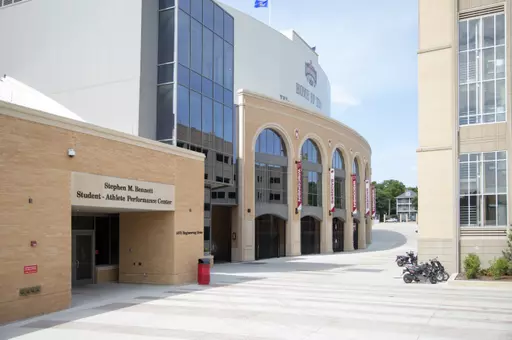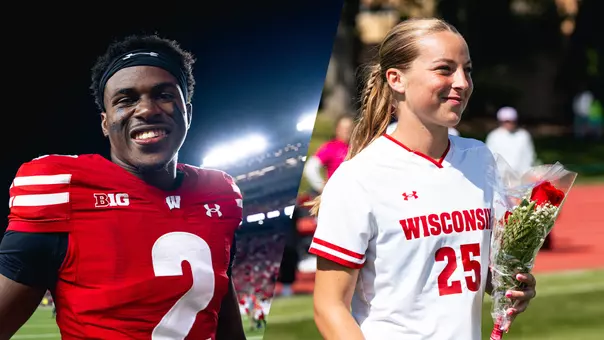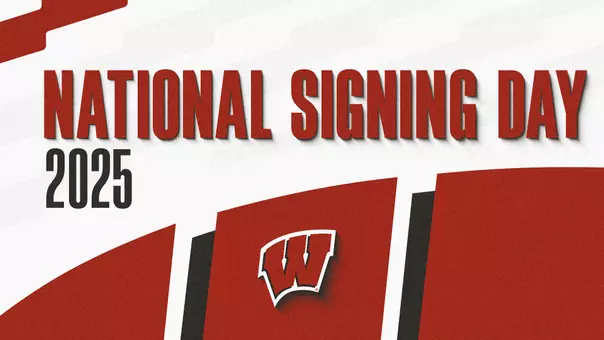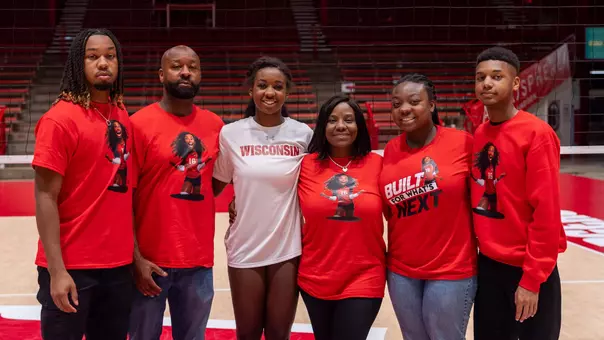The Future is Now: Behind the partnership with Under Armour
July 01, 2016 | General News, Andy Baggot
Wisconsin launches 10-year agreement with apparel industry leader
This story originally was published on Oct. 9, 2015, when Under Armour and UW Athletics announced their 10-year partnership.
 |
||
|
BY ANDY BAGGOT
UWBadgers.com Insider
Video: Night of the New Red Threads
MADISON, Wis. — The project took decades to build and its foundation consists of materials you won't find in any hardware store.
Yes, there is steel, concrete and mortar. But there is also blood, heartache, sweat and euphoria.
"Our brand is very important," Wisconsin Director of Athletics Barry Alvarez said. "We took 25 years to build this brand and I think we have a very valuable brand. I do not want to go away from the brand.
"It's something that we have earned and what we want to build off of."
Those intentions are at the heart of a new footwear and apparel agreement with Under Armour, a 10-year, $96-million (retail value) deal – in addition to guaranteed licensed sales royalties of $4.5 million – that was approved Friday by the Board of Regents and goes into effect on July 1, 2016.
The massive contract clearly defines Wisconsin as one of the elite brands in college athletics. At $10 million annually, it currently ranks as one of the most lucrative among the 14 Under Armour schools.
Wisconsin's current apparel arrangement with adidas — which began in 2001 and was extended most recently in 2010 — expires after the 2015-16 school year.
Alvarez said he spoke with representatives from adidas and Nike before opting for Under Armour, which was founded in 1996 by Maryland alum Kevin Plank and recently became the No. 2 company worldwide in athletic footwear and apparel revenue.
"We did our due diligence," Alvarez said.
The conversation with Under Armour dates back to last February when Plank and his staff made a day-long presentation to a Wisconsin delegation headed by Alvarez. The meeting at the company's headquarters in Baltimore coincided with the first Big Ten Conference men's basketball game between the Badgers and Maryland in nearby College Park.
Prior to that meeting, Under Armour dispatched a research team to Madison looking to capture the essence of the city and campus. Hundreds of diverse photos were used to construct what ultimately became a winning pitch.
"They wanted to know about Wisconsin," Alvarez said. "The story they have — the story they came away from here with — parallels the brand that we've established.
"They're smart enough to realize that we're not going to be a school that changes uniforms and helmets every week. We're beyond that. That's just not us. Yet we're going to be stylish and we'll have equipment and a brand that attracts athletes."
How would one describe the Wisconsin brand when it comes to athletics?
Chris McIntosh has a unique vantage point to address that question. Not only did he grow up in Pewaukee, he was a standout offensive tackle for the Badgers from 1995-99, has a degree from Wisconsin and currently works as an assistant to Alvarez.
"The brand is a feeling, right, so it's difficult to articulate," McIntosh said. "But you hear people talk about the way we do things. We develop our kids and the way we carry ourselves. We do it the right way.
"Objectively, Wisconsin is different. I don't think anybody would disagree with that.
"Biased opinion? It's special."
McIntosh, a former first-round NFL draft pick whose pro career was cut short due to injuries, said the Wisconsin brand embodies development and consistency in pursuit of a grand conclusion.
"What our job is is to provide this experience, this four or five-year experience, to about 850 kids that changes who they become," he said. "That because of this experience — competition on the field and high expectations in the classroom and time management and stress and all these things that go into it — our kids become someone that they wouldn't have been without that."
McIntosh joined Alvarez on the trip to Under Armour. So did Jeff Schmidt, the associate athletic director for administration and legal affairs.
In addition to the "young, vibrant, enthusiastic" feel to the retailer's methods, Schmidt said there was a telling moment in the pitch. That's when Under Armour officials displayed partial pictures of football uniforms worn by the Badgers and two other Adidas clients in the Big Ten: Indiana and Nebraska. The red and white features were so similar that no one from the Wisconsin contingent could tell them apart.
"That was an emphasis of their presentation that certainly stood out to us," Schmidt said. "With this partnership, we want to create a unified, consistent look across all 23 of our sports."
Alvarez said Under Armour's creativity and grassroots effort in creating high school camps, combines and all-star games was a big selling point.
"It's all part of recruiting," he said. "Some people use it more than others. I think our brand sells more than uniforms, yet I'm not naïve enough to understand this isn't important to athletes. They want to wear certain brands."
The Wisconsin athletic department splits licensing proceeds with the campus. Alvarez said the extra revenue generated through the Under Armour deal will be "considerable" and will help to fund an elevated experience for Badger student-athletes.
Schmidt said many of the current (and, no doubt, future) Wisconsin student-athletes grew up wearing Under Armour.
"This partnership is about more than just dollars," he said. "It's certainly a big portion of it, but when you talk about the Under Armour brand, it's amazing when you look and see how much of the youth market they've captured.
"There's been a bit of a changing of the guard there and I think that's what makes Under Armour a great partner."
Alvarez was on the ground floor of the construction project that brought Wisconsin athletics into national prominence over the last quarter century. He turned the football program from also-ran to Big Ten powerhouse from 1990 to '06. Since becoming AD in 2004 he's overseen multiple capital projects that define the school as a first-class destination for student-athletes.
What sold him on Under Armour as a new footwear and apparel partner?
"It wasn't one thing," he said. "It wasn't just the contract itself. It wasn't just their creativity. It wasn't just their marketing. It wasn't just their product. It wasn't the grassroots programs that they have. It was all of those things."













